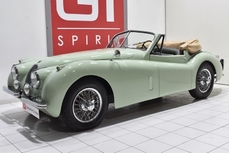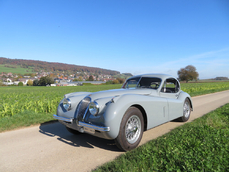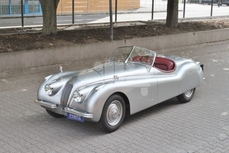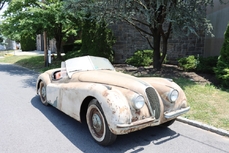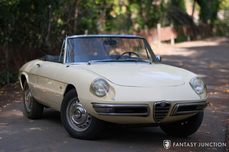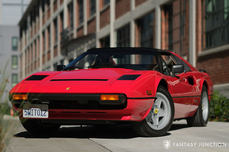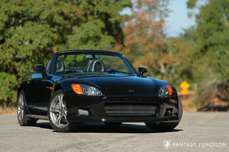Jaguar XK120 3.8 Liter Inline-6 no. LA2767-8 1950
Allmän beskrivning :
1950 Jaguar XK 120 Alloy Roadster
Chassis No. 670110, engine no. LA 2767-8
Brushed Aluminum with Blue Leather Interior
In 1948, Jaguar revealed the XK 120 to the British public as a potential concept car to showcase the firms’ capability with leading edge technology and the latest in aerodynamic design. For the demure Brits, emerging from post-war economic austerity, the XK120 caused quite a stir. The newly conceived XK 120 was nothing short of a revelation. This truly avant-garde car quickly demonstrated to the world that Britain had the technical capacity and fortitude to deliver a beautiful and innovative world-class sports car. Although originally intended to be a concept car to showcase Jaguar’s remarkable new twin-cam inline-6 cylinder engine, the breathtaking styling and genuine 120 mph performance, coupled with an affordable price, captured the imagination of the world. In short order, the largely hand-built aluminum-bodied car was rushed into limited production as orders came flooding in. With time and delivery pressures growing, Jaguar reengineered the car for mass production with steel bodies, developing stamping tools capable of producing thousands of cars. A mere 242 aluminum examples were built before the XK120 shifted to steel production, making the lighter and largely handcrafted aluminum cars forever rare and desirable.
This XK120 is a particularly unique alloy example, originally designated for delivery to James Cooke of Toronto Canada. One of just 184 LHD cars built, the car was completed on February 17, 1950, finished in Pastel Blue with Duo-Blue interior, and shipped to Canada. Although little is known about the car during the time it resided in Canada, the next documented owner is known to have been Mr. John D. DeHaan, who purchased the car from Fred Lake, of Brea, California in 1981. At that time, Mr. Lake had two early alloy XK120s for sale, 670110 and 670120, and DeHaan selected 670110 as a rolling chassis, complete with the disassembled alloy body, but no engine. At the time of purchase, the car was titled in California using the engine number W10438. Mr. DeHaan intended to restore the car but never ended up doing so and sold the car to noted Jaguar expert Jim Groom of Groom’s Sportscar Services, Berkeley, CA. Shortly after that, the car was purchased by the current owner, who commissioned a restoration, configuring the car specifically for vintage racing. He elected to honor the beautifully constructed alloy body by finishing it in brushed aluminum, with the hood draped in colorful livery depicting the Union Jack. In 2010, Jim Groom was enlisted again to rebuild the engine currently in the car. From 2009 - 2017, the car competed in numerous races on the West Coast, competing in one or two vintage racing events each year, passing technical inspections as noted in the accompanying CSRG Vehicle Log Book #09-001.
Today the car presents as a tribute to the purity and sculptural quality these early XK120s are so admired for. The purposeful raw aluminum body is evocative and handsome, wearing evidence of use with pride. Minor scratches, dents, and occasional surface imperfections add to this car’s authenticity and no-nonsense presentation. Overall, the body is in very good condition showing nice contours and panel fit, none of which can be fudged via preparation, filler, or paint. What you see on the surface is actually the body. The comprehensive restoration work performed on the car included removing the windscreen, adding ducted fully covered rear fender spats, a roll bar, and removing the bumpers. In place of the windscreen, a matching formed aluminum cowl fairing and rear view mirror shroud complete the impressive, handcrafted period racing look. Components throughout the car were thoughtfully and comprehensively addressed with vintage appearing presentation in mind. The hood, door (the passenger’s door is fixed), and trunk shut and latch properly. The exterior look is completed with understated painted steel wheels, an original Jaguar nose badge, chrome-trimmed headlights, and grille. Overall the exterior visual presentation is one of a delightfully conceived racecar that immediately charms anyone who appreciates the bombastic fury and delight of a purposeful machine crafted with pride.
The nicely restored interior, now shows a light patina, which has settled very evenly into the materials and adds to the cockpit like feel of the car. The leather seats are properly bolstered and comfortable with a nice hue and sheen, while the matching trimmed door panels follow the body contours against the raw aluminum structure. The roll bar, colorfully boasting the many races in which this car has competed features a padded headrest and properly anchored racing seatbelts. The car’s owner is on the tall side and the car is currently configured to accommodate a tall driver, with smaller (but correct appearing steering wheel) and fixed driver’s seat mounted as close to the floor as possible. A few race required switches on the otherwise largely original dash, a nice set of original instruments, an original black steering wheel, and thoughtfully engineered metal foot pedals further complete the purposeful cockpit, all of which is consistently finished and in very presentable condition. None of the interior components are out of visual character with the exterior appearance of the car, in fact, the look is cohesive and uniformly finished even when opening the doors to reveal the painted metal floor and aluminum formed door skins, here again, finished in raw aluminum. The underside of the trunk features primed red-oxide lightened steel substructure much like aircraft fuselage design, here too very much in keeping with the interior look with the trunk compartment painted metal contrasting against the raw aluminum fuel tank, here too celebrating the elegant and purposeful engineering of a race-bred sports car.
Under the hood, the beautiful 3.8 liter dual-overhead camshaft engine, sourced from a later car, is perfectly at home. The casting finishes have just the right amount of sheen in combination with a blend of correct components and select handmade components in keeping with the vintage nature of the car. The restoration work has settled here as well but the finishes are consistent throughout. The overall condition of the engine is very nice, displaying handsome luster and detailing beyond what is generally seen in a typical vintage racecar. The undercarriage still remains very nicely done revealing the attention to detail given when restored. The car appears to have been properly cleaned and currently shows only minor areas of aging since the restoration was completed. In all, the underside components are very presentable, consistent with the themes of the car, demonstrating proper care and use.
The car starts easily erupting in a fury of sound that captivates innocent bystanders even at a distance. The engine sounds are raw and eager, much like the livery, once again cohesively creating a total experience even when sitting at idle. The gearbox is easily engaged and once underway, within moments you are fully enveloped in a furious combination of wind and noise, much like a fighter pilot might have felt readying for take off. Acceleration is brisk in all gears with tremendous pull and great power as revs climb and you experience that combination of vibration and roar as speeds increase. Handling is a delight when at speed, particularly enhanced by the open coachwork and low profile windscreen.
This is an outstanding opportunity to acquire a car that captures the XK120 spirit, in a wonderfully competent and sorted vintage race car. A genuine alloy bodied XK120, this car is exceptionally rare and represents strong value for such a significant car. It has been built by one of the best in the business and is a well-sorted turnkey car that is competitive on the track in addition to being California titled and street legal. This Jaguar offers the next fortunate racing enthusiast a rare opportunity to own and drive a very special and uniquely prepared car, ready for vintage events while still capable of delighting crowds of appreciative onlookers at any show.
http://fantasyjunction.com/cars/2112-Jaguar-XK120%20Alloy-3.8%20Liter%20Inline-6
1950 Jaguar XK120 3.8 Liter Inline-6 no. LA2767-8 is listed såld on ClassicDigest in Emeryville by Fantasy Junction for $160000.
Fakta i bilen
Karosstyp : Personbil Märke : Jaguar Modell : XK120 Modellversion : 3.8 Liter Inline-6 no. LA2767-8 Motorvolym : 3.8 Årsmodell : 1950 Läge : Emeryville
Såld
Information om säljaren
Såld
People who viewed this Jaguar XK120 also viewed similar Jaguar listed at ClassicDigest
Other cars listed for sale by this dealer
om Jaguar
Åh, historien om Jaguar, från dess tidiga dagar som SS Cars Ltd. till sin höjdpunkt med D-typen och gatubilsevolutionen i form av den ikoniska E-typen. Det finns något alldeles brittiskt över denna berättelse, och jag ska berätta den som en brittisk journalist skulle göra.
I början:
Vår resa in i Jaguar-världen börjar på 1930-talet, när ett företag som kallades SS Cars Ltd. dök upp. Trots den olyckliga sammanträffandet av deras initialer med de stigande politiska spänningarna i Europa började de producera stilfulla och prestandainriktade bilar. SS 100, som introducerades 1936, var en symbol för elegans och hastighet och lade grunden för vad som skulle bli Jaguar.
Jaguars födelse:
När skuggan av andra världskriget närmade sig beslutade SS Cars Ltd. klokt att distansera sig från SS-initialerna. Så 1945 blev de officiellt Jaguar Cars Ltd., ett namn som snart skulle bli synonymt med brittisk lyx och prestanda.
XK-serien:
Jaguars efterkrigstid gav oss XK 120, en verklig sensation 1948. Med sin strömlinjeformade design och en kraftfull 3,4-liters raksexmoters blev den världens snabbaste seriebil. XK 120 var ritningen för det som komma skulle - Jaguar som förenade stil med hastighet på ett unikt brittiskt sätt.
D-typens dominans:
Sedan kom D-typen, en sann racinglegend. Introducerad 1954, vann den Le Mans tre gånger på 1950-talet och visade Jaguars tekniska skicklighet. Med sin innovativa monokokkonstruktion och den ikoniska fenan bak var D-typen höjdpunkten av Jaguars framgång inom motorsport.
E-typens framträdande:
Men den verkliga vändpunkten kom 1961 med introduktionen av E-typen, ofta beskriven av Enzo Ferrari som "den vackraste bilen som någonsin byggts". Dess långa motorhuv, böljande kaross och en 3,8-liters motor som levererade upphetsande prestanda gjorde den till en omedelbar klassiker. E-typen var inte bara en bil; den var ett konstverk på hjul och kunde nå 150 mph på vägen.
Gata och racingsuccé:
E-typens skönhet matchades av dess förmåga på racerbanan. De lätta E-typarna var särskilt framgångsrika i olika racingevenemang och cementerade Jaguars rykte som en kraft att räkna med inom motorsport.
Raffinemangets ålder:
När vi fördjupar oss i Jaguar-historien finner vi att 1950-talet och 1960-talet var en tid av raffinering och expansion. Tillsammans med den magnifika D-typen och den ikoniska E-typens framträdande introducerade Jaguar modeller som ytterligare befäste sitt rykte för lyx och prestanda.
MK2:
I slutet av 1950-talet presenterade Jaguar MK2, en sportig sedan som kombinerade elegans med kraft. Denna eleganta fyradörrars salong var en favorit bland bankrånare och polisen, tack vare dess exceptionella hastighet och hantering. MK2 var en symbol för Jaguars förmåga att förena sofistikering med prestanda och hade också en framgångsrik racingkarriär.
XJ6:
Hoppa fram till 1968 och Jaguar lanserade en bil som skulle definiera lyxbilar i decennier framöver - XJ6. Det var ett mästerverk i teknik och design med en jämn raksexmoters, oberoende bakre fjädring och en rymlig, vackert inredd interiör. XJ6 var en symbol för brittisk elegans och erbjöd en så smidig åktur att det kändes som om den gled över vägen. Den blev flaggskeppsmodellen för Jaguar och satte standarden för lyxbilar och visade en nivå av raffinering som imponerade på konkurrenterna.
Blandningen av klassiskt och modernt:
Medan MK2 och XJ6 representerade utvecklingen av Jaguars sedanmodeller, bibehöll de märkets engagemang för prestanda och lyx. Dessa bilar hörde inte bara hemma på racerbanan; de trivdes lika bra på de stora boulevarderna som på en avslappnad körning genom den engelska landsbygden.
Utmaningarna av förändring:
Men när 1970-talet närmade sig, ställdes Jaguar, liksom många brittiska biltillverkare, inför ekonomiska utmaningar och ägarförändringar. British Leyland-eran förde både möjligheter och svårigheter med sig när varumärket navigerade genom olika sammanslagningar och övergångar.
Ändå fortsätter arvet från MK2 och XJ6, tillsammans med D-typen och E-typen, att definiera Jaguar som en tillverkare som förenar tidlös elegans med en anda av prestanda. Dessa klassiska modeller, vare sig de körs på slingrande vägar eller står som samlarföremål, tjänar som ett vittnesbörd om Jaguars långvariga närvaro inom den automobila exklens värld.
Jaguar-historien, från dess tidiga dagar som SS Cars Ltd. till skapandet av ikoner som E-typen, MK2 och XJ6, är en resa som speglar essensen av brittisk bilkultur - en blandning av lyx, kraft och stil som fortsätter att fängsla entusiaster och samlare över hela världen.


